October 2003
1st October
This is a fungus (Dacrymyces stillatatus) growing on a rotting log.
This is another of my 'Second Spring' images; this time the Lesser Stitchwort. I'll leave you to work out how I took this picture.
Two sets of seedpods, on the left, the Meadow Vetchling; on the right, the Broom.
The Meadow Vetchling first flowered in June. It has steadily been flowering and growing ever since. This specimen is over 4 feet tall, growing over Marsh Cinquefoil and Willow.
This is the view South from the stream on leg 1. Nice Autumn light.
2nd October
Went up to the Annexe, today. More fungi than I could have anticipated.
3rd October
Annexe again, today.
4th October
Very cold and wet, today.
This cluster of mushrooms nearly covered an old stump. Hypholoma, I think.
Then, looking closer I spotted this Wood Sorrel growing on the stump, too. (You can just see it at the top right of the mushrooms). Strange place and very unseasonal.
7th October
Constant rain for the past 2 days, but here are two recent images:
All parts of the Bog Asphodel turn orange then red once the seeds are setting.
This little yellow sedge was growing at the edge of the heather.
8th October
This picture just shouts "Autumn".
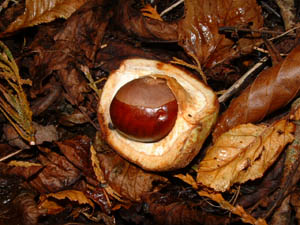
These are the unmistakable leaves of the Horse Chestnut.
And under the Chestnut? A horde of Puffballs (Lycoperdon spp)
9th October
This is a close-up of a Plume Moth. Your task (again) is to work out how I got it.
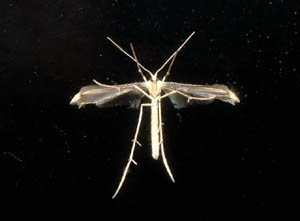
10th October
More fungi, today:
This
one is, I think, a Cystolepiota.
The following two were on the same piece of dead Willow. The orange one is Tremella mesenterica, known as the Yellow Brain fungus.
A couple of clusters of these were growing through moss, on an old stump. The stems are a vivid lemon yellow.
This tiny white Leptoglossum retirugum (about 1cm across) was growing directly on the tips of the moss:
And this Slippery Jack -a very viscid Boletus was growing under Scots Pine.
11th October
In June, I showed the Pale Persicaria. A bit further on I've found the (non-pale) Persicaria. The picture shows why it's sometimes called Redshank.
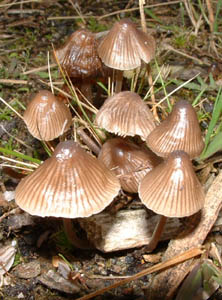
I rather liked these little (1.5 cm) mushrooms growing at the side of the path. Mycena inclinata, I think.
And these yellow finger-shaped Calocera cornea were growing on the end of an old log.
Finally, today, a worm swimming in a puddle. Looks like it might have some sort of infection, and was maybe trying to use the water to get rid of it.
And finally, today, the Heath Speedwell has returned. Lovely
colour.
12th October
Lots more interesting fungi, today. First, Clavaria acuta.
This Clavulina cineria was growing through the moss, under pine trees.
This Amethyst Deceiver has purple gills.
Another Russula, this time growing directly on pine, so perhaps the Sickener.
14th October
Saw a few Red Admirals today, and a couple of Ringlets. The last of the Swallows were gathering on the phone wires - most left a month ago. I spotted a few Lesser Spearworts (re)appearing at the edge of the stream - picture perhaps on Saturday. The bats are very active from about 8 pm...we have to duck to avoid them. Everything is very autumnal, now - leaves falling; trees are yellow, orange and red. All in all a beautiful time of year.
15th October
Plants still flowering include:
Herb Robert, Lesser Spearwort, Meadow Buttercup, Dandelion, Daisy, Ox-Eye Daisy, Bush Vetch, Meadow Vetchling, Bird's Foot Trefoil, Red and White Clover, Creeping Thistle, Hardhead, the Sow Thistles (Perennial, Smooth and Prickly), Hawkbits and Cat's Ear, Rose-Bay Willowherb, Sneezewort, Figwort, Square-stalked St. John's Wort, Ragwort, Groundsel, Persicaria, Devil's Bit Scabious, Hedge Woundwort, Cow Parsley, Watercress, Tormentil, Meadowsweet, Nipplewort, Fuchsia, Bramble, Raspberry, Ivy and Heath Speedwell.
With frost being predicted regularly, I'm sure that list will drop, soon.
Here's a picture of a Rook:
"A Rook on its own is a Crow, and a Crow in a crowd is a Rook."
October 16th
Bright, beautiful weather, today. So went to the hedgerow and took a representative sample of images. Here are a couple of montages. No id's - you should know them all by now.


In fact, you could have fun working out what they are. Use the feedback form to send your suggestions. (I'll take genus for the mushroom. It's about 5 cm diameter, has a stem ring and white oval spores)
More, tomorrow.
17th October
Here's another montage, all photos taken yesterday. Answers to feedback as before.

Another, tomorrow.
18th October
And here's today's Quiz montage. All photos taken yesterday.
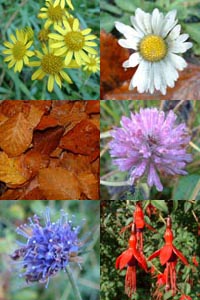 Answers
to Feedback
as before.
Answers
to Feedback
as before.
19th October
Ok, no more competition pictures, but the competition will remain open until about mid-week. Now back to the images.
I went up to the Annexe, today, so that's where the pictures are.
20th October
We had a hard frost last night, so I expect that's the end of the 'second spring'.
For those of you wrestling with the quiz, here are a few of the images at a higher quality.
No names - yet!

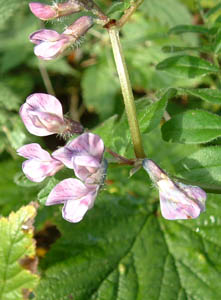
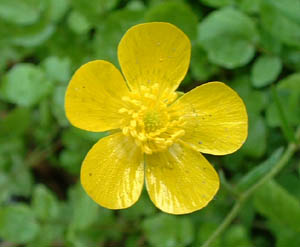
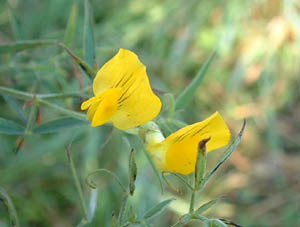
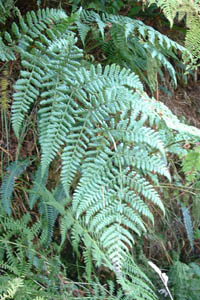
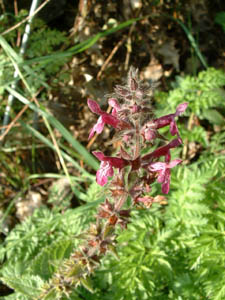
21st October
A hard frost on Sunday and hailstones today have killed a few plants, but some are still soldiering on:
From these images, you can see from the shadows how low the sunlight is, at this time of year.
On the left, the Bird's Foot Trefoil; on the right, Slender St. John's Wort.
Two more fungi growing in the grass in the middle of the path:
I like it when I can capture the rain or dew resting on the leaves and flowers:
On the left, Clover, and on the right, the last of the Self-heal.
22nd October
An interesting one to start with, today. Liverworts propogate by spores. This Marchantia polyforma carries its spores in umbrella-like structures.
This cluster of Ink Caps was pushing through the litter under
a Beech. In the process, they had excavated some new Beech seedlings that were
lying beside them.
24th October
The answers to the quiz are over on the news page. That lets the quiz stay live for a little while, yet.
There is another, much harder, quiz over here
Give it a try if you like. All photos were taken today. When that quiz is over, I'll bring the pictures to this page with descriptions. All quiz plants have already been shown on the site.
26th October
A few interesting images today, between heavy rain showers:
First, a shot of leg1 South - very wintery - never mind autumn.
First, two fungi growing about a foot apart. On the left another Helvella - the Black, I think. The waxy one on the right has a very thick stem.
A very dark pink Bramble flower has just opened
These
nettles had suddently sprouted white shoots. Not sure whether it's the cold or
something in the ditch.
27th October
A new plant in the boggy part, today - the Lousewort.
Two more fungi growing on the mossy bank. Hypholoma on the left; the Omphalina on the right shows mosses and Liverwort, too.
These
Mosses were also very colourful.
Two more fungi. The Russula on the left has a deeply cracked upper surface. The one on the right might be a Psathyrella.
28th October
Spore analysis is one of the aids to identifying fungi. Here are spores of 4 different fungi showing some of the variations in shape and colour. Each spore is around 3 to 10 microns across.
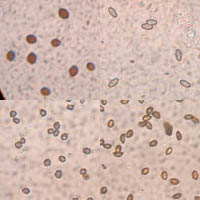
And this is an attempt to show some of the spore detail:

These are the spores in the upper right quadrant of the above montage at x400.
I always find it fascinating to see what's going on right under our noses.
29th October
I found a Sweet Chestnut in the Annexe. Didn't realise it was there until the leaves started to change colour and drop.
30th October
I've decided where next year's project will be:
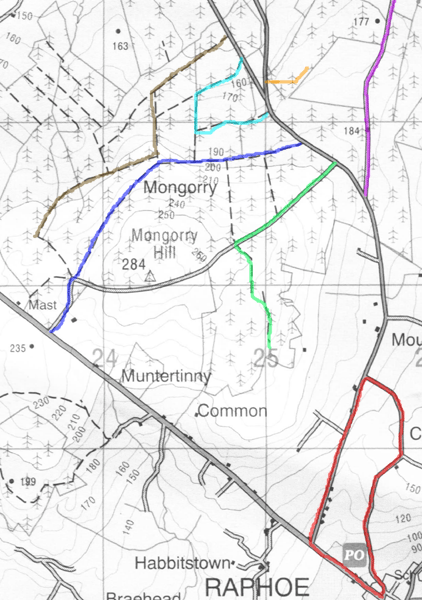
The red line is the existing Hedgerow
The dark blue line runs through recently deforested land, then enters a mixed deciduous and coniferous plantation, with a stream to one side. A large bog with Sundew is at the southern end.
The pale blue line runs through mixed deciduous and coniferous plantation - this is rich Orchid land.
The purple line has Coniferous plantation to one side and deforested plantation to the other. Terminates in a large pond. Sundew and Bog Asphodel are prominent here.
The orange line has many mosses, lichens and liverworts.
The green line leads to the top of our hill and is in recently deforested (but even more recently replanted) coniferous plantation. Rough moorland contains heaths and heathers. There are also many Willows on this walk.
The brown line starts off in mixed forestry and leads to a large stream. There are many orchids, Dragonflies and Damsel flies on this walk.
So that gives me 7 walks, enabling me to visit each one once per week. All of our environments are covered from hedgerow through bog, heath, rough pasture, old forestry, new forestry and recently deforested plantation. Water will feature from small to large streams and the pond. Altitude varies by about 200m.
31st October
The feature of this photo is the dark purple Ergot growing on
the Cock's Foot. It's a poisonous fungus.
Two water plants next. On the left, the Bog Pondweed; on the right a Callitriche.
I think this one should be in a quiz. It's the seed of the Angelica.
This is a real surprise. Tomorrow is November, and this Hedge Woundwort has decided to start all over again.
October had more to show than I expected..let's see what November brings.
Back to Home page Back to September On to November Feedback Annexe Map News Plant list